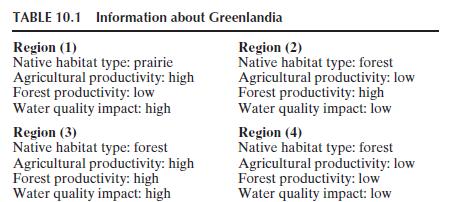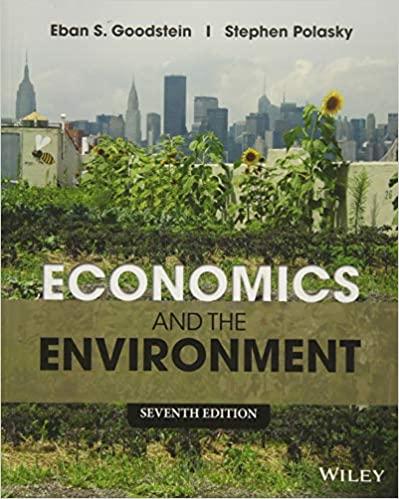The county of Greenlandia has four regions. Information for the four regions is shown in Table 10.1.
Question:
The county of Greenlandia has four regions. Information for the four regions is shown in Table 10.1. Suppose there are three types of land use: (1) agriculture, (2) managed forestry and (3) conservation to maintain native habitat. As a land manager, you must choose a land use for each of the four regions (note: you can choose different land uses in the different regions). You are interested in the following objectives: (1) carbon sequestration, (2) water quality, (3) agricultural production, (4) timber production, (5) forest birds, and (6) grassland birds. Consider the following simple “models” of provision of ecosystem services and biodiversity conservation:
● Carbon: 100 units of carbon in native forest, 70 units of carbon in managed forest, 50 units of carbon in native prairie, and 20 units of carbon in agriculture.
Table 10.1

● Water quality: native habitat (forest or prairie): 100 units of water quality in high impact zones and 50 units of water quality in low impact zones; managed forests: 60 units of water quality in high impact zones and 30 units of water quality in low impact zones; agriculture: 0 units of water quality in either zone.
● Agricultural production (occurs only on land put into agricultural production):
100 units of production in high agricultural productivity zones and 20 units of production in low agricultural productivity zones.
● Timber production (occurs only on land put into managed forest): 100 units of production in high timber productivity zones and 20 units of production in low timber productivity zones.
● Forest birds: 100 units for native forest habitat, 50 units for managed forest, and 0 units for prairie or agriculture. If a forest unit shares a border (corners do not count) with agriculture then the forest bird score is reduced by 50%.
● Grassland birds: 100 units for native prairie, 20 units for agriculture, and 0 units for native forest or managed forest.
a. What is the land use plan you would choose if you were trying to maximize the score for forest birds? For this land use plan, what is the score for each of your objectives (carbon, water quality, agricultural production, timber production, forest birds, and grassland birds)?
b. What is the land use plan you would choose if you were trying to maximize the score for grassland birds? For this land use plan, what is the score for each of your objectives (carbon, water quality, agricultural production, timber production, forest birds, and grassland birds)?
c. Suppose that private landowners wish to maximize the market value of production from their land and suppose that each unit of agricultural production is worth $2 and each unit of timber production is worth $1 (i.e., they wish to maximize 2 * agricultural production + 1 * timber production). What would each land owner choose to maximize their market returns? For this land use result, what is the score for each of your objectives (carbon, water quality, agricultural production, timber production, forest birds, and grassland birds)?
d. Suppose that we instituted a “payments for ecosystem services” program.
If landowners are paid $1 for each unit of carbon and $1 for each unit of water quality, what would each landowner choose if they were interested in maximizing their sum of market returns (2 * agricultural production + 1 *
timber production) and payments for ecosystem services? For this land use result, what is the score for each of your objectives (carbon, water quality, agricultural production, timber production, forest birds, and grassland birds)?
e. Suppose we expanded the “payments for ecosystem services” program so that it also paid landowners $1 for each unit of forest birds and $1 for each unit of grassland birds. Now what would each landowner choose if they were interested in maximizing their sum of market returns (2 * agricultural production + 1 * timber production), payments for ecosystem services, and bird conservation? For this land use plan, what is the score for each of your objectives (carbon, water quality, agricultural production, timber production, forest birds, and grassland birds)?
Step by Step Answer:

Economics And The Environment
ISBN: 9781118539729
7th Edition
Authors: Eban S. Goodstein, Stephen Polasky





